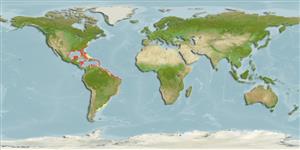Common names from other countries
>
Eupercaria/misc (Various families in series Eupercaria) >
Sparidae (Porgies)
Etymology: Archosargus: Greek, archo = anus + Latin , sargus = sea bream (Ref. 45335).
More on author: Linnaeus.
Environment: milieu / climate zone / depth range / distribution range
Ecologia
marinhas; estuarina associadas(os) a recifes; intervalo de profundidade 1 - 40 m (Ref. 115835). Subtropical; 22°C - 30°C; 41°N - 58°S, 98°W - 34°W
Western Atlantic: New Jersey, USA and northeastern Gulf of Mexico to Argentina (Ref. 4517). Absent from the Bahamas (Ref. 26938).
Length at first maturity / Tamanho / Peso / Idade
Maturity: Lm 8.0 range ? - ? cm
Max length : 33.0 cm TL macho/indeterminado; (Ref. 7251); common length : 20.0 cm TL macho/indeterminado; (Ref. 9626); peso máx. Publicado: 550.00 g (Ref. 9626); Idade máx. registada: 2.00 anos (Ref. 3422)
Espinhos dorsais (total) : 13; Raios dorsais moles (total) : 10 - 11; Espinhos anais: 3; Raios anais moles: 10 - 11. Large intestine makes up 90% of digestive tract and is twice the standard length, on the average; the stomach with 7 digestive caeca attached near the pyloric region. Pelvic fin coloration totally or partially dark in males; orange colored in females. Large dark spot (about same size as eye) below lateral line just behind gill opening (Ref. 26938).
Commonly found over mud bottoms in mangrove sloughs and on vegetated sand bottoms, sometimes in brackish water and occasionally also in coral reef areas near mangroves. Feeds on benthic invertebrates (small bivalves, crustaceans), as well as on plant material.
Robins, C.R. and G.C. Ray, 1986. A field guide to Atlantic coast fishes of North America. Houghton Mifflin Company, Boston, U.S.A. 354 p. (Ref. 7251)
Categoria na Lista Vermelha da IUCN (Ref. 130435)
CITES (Ref. 128078)
Not Evaluated
Ameaça para o homem
Harmless
Utilização humana
Pescarias: espécies comerciais
Ferramentas
Relatórios especiais
Descarregue XML
Fontes da internet
Estimates based on models
Preferred temperature (Ref.
115969): 22.8 - 28, mean 25.8 (based on 456 cells).
Phylogenetic diversity index (Ref.
82804): PD
50 = 0.6250 [Uniqueness, from 0.5 = low to 2.0 = high].
Bayesian length-weight: a=0.02042 (0.01730 - 0.02410), b=2.98 (2.94 - 3.02), in cm Total Length, based on LWR estimates for this species (Ref.
93245).
Nível Trófico (Ref.
69278): 2.9 ±0.1 se; based on diet studies.
Resiliência (Ref.
120179): Elevada, tempo mínimo de duplicação da população menor que 15 meses (K=1.27; tm=0.4; tmax=2).
Fishing Vulnerability (Ref.
59153): Low vulnerability (23 of 100).
Climate Vulnerability (Ref.
125649): Moderate vulnerability (42 of 100).
